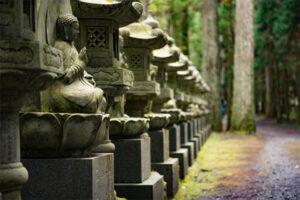We use three different types of characters to write Japanese words.
One is kanji or Chinese characters. They were made in ancient China, and each character has its own meaning. Either one character alone or a combination of characters represents nouns and concepts.
The other two writing systems are hiragana and katakana. They were created in Japan by making use of parts of some kanji, and each letter works like an alphabet because each hiragana or katakana letter represents one sound. Hiragana is usually used in combination with kanji characters to form verbs, adjectives and adverbs. On the other hand, katakana is mainly used to write foreign words and express onomatopoeic words.
Japanese children learn hiragana first because it’s most frequently used and there are about 50 symbols in hiragana. Then, they learn katakana since it consists of the same number of symbols as hiragana.
So how many kanji characters do you think we have to learn for daily use?
a. 50
b. 200
c. 1,000
d. 2,000
The correct answer is “d”. Learners must be overwhelmed by the huge number.
In addition, kanji has two different readings: on-yomi and kun-yomi. On-yomi is closer to the original Chinese language. The kun-yomi reading is used to show the traditional Japanese pronunciation.
Kanji can have multiple on-yomi and kun-yomi readings, and they may sometimes have either on-yomi or kun-yomi readings. We have to remember kun-yomi and/or on-yomi for each kanji character. For example, my family name, “高野 (Takano)”, is composed of two kanji characters and pronounced with kun-yomi.
But if you pronounced it with on-yomi, you would say “koya”. The sound “koya” reminds us of “高野山 (Koya-san)”. Koya-san refers to the mountainous area in Wakayama Prefecture, situated in the Kinki region, dedicated to the Shingon sect of Buddhism. It is home to Kongobu-ji Temple, a World Heritage site. In fact, my ancestor is said to have been a Buddhist monk.

You may not be able to understand why we use such bothersome characters. Should Japanese use only hiragana and katakana because they are much easier to learn like alphabets?
Almost all of us must reject this proposal.
As I mentioned above, each kanji character has its own meaning. Parents usually name their child with kanji, and they put one or more meanings into the name. If I just heard of my first name, “Yuki (雄希)”, I could not guess how my parents expected me to behave in my life. Japanese also has punctuation marks but no interword spaces. We would have chronic difficulties finding a phrase without kanji.
Kanji was not from Japan, but we’ll never discard it because it has been part of our identity. You must know our culture more deeply if you learn Japanese writing system. Even Japanese people usually spend more than ten years to learn kanji in common use. Do mastering kanji slowly, and you will not be defeated.
YUKI Takano
e-mail: yuki.takano@i3ws.co.jp
